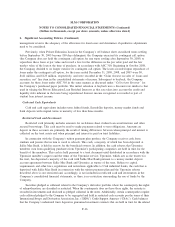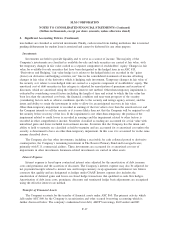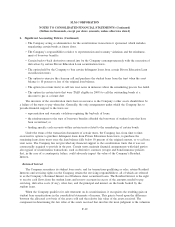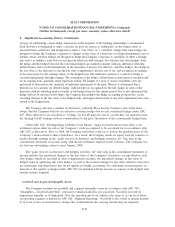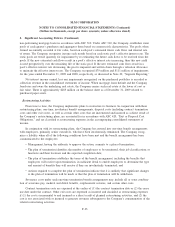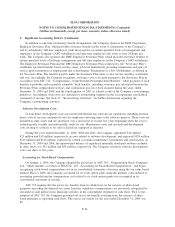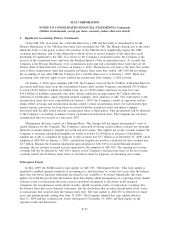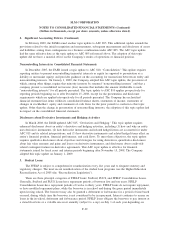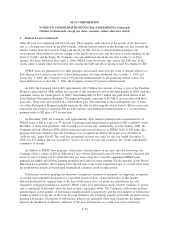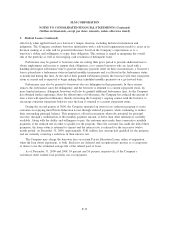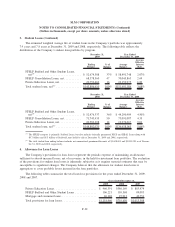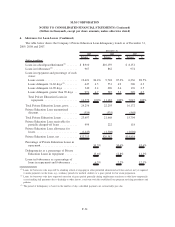Sallie Mae 2009 Annual Report Download - page 152
Download and view the complete annual report
Please find page 152 of the 2009 Sallie Mae annual report below. You can navigate through the pages in the report by either clicking on the pages listed below, or by using the keyword search tool below to find specific information within the annual report.2. Significant Accounting Policies (Continued)
Income Taxes
Income taxes are recorded in accordance with ASC 740, “Income Taxes.” The asset and liability approach
underlying ASC 740 requires the recognition of deferred tax liabilities and assets for the expected future tax
consequences of temporary differences between the carrying amounts and tax basis of the Company’s assets
and liabilities. To the extent tax laws change, deferred tax assets and liabilities are adjusted in the period that
the tax change is enacted.
“Income tax expense/(benefit)” includes (i) deferred tax expense/(benefit), which represents the net
change in the deferred tax asset or liability balance during the year plus any change in a valuation allowance,
and (ii) current tax expense/(benefit), which represents the amount of tax currently payable to or receivable
from a tax authority plus amounts accrued for unrecognized tax benefits. Income tax expense/(benefit)
excludes the tax effects related to adjustments recorded in equity.
New provisions under ASC 740, pertaining to the accounting of uncertainty in income taxes, were adopted
on January 1, 2007. Under ASC 740, an uncertain tax position is recognized only if it is more likely than not to
be sustained upon examination based on the technical merits of the position. The amount of tax benefit
recognized in the financial statements is the largest amount of benefit that is more than fifty percent likely of
being sustained upon ultimate settlement of the uncertain tax position. The Company recognizes interest related
to unrecognized tax benefits in income tax expense/(benefit), and penalties, if any, in operating expenses.
Earnings (Loss) per Common Share
The Company computes earnings (loss) per common share (“EPS”) in accordance with ASC 260,
“Earnings per Share.” See Note 12, “Earnings (Loss) per Common Share,” for further discussion.
Discontinued Operations
A “Component” of a business comprises operations and cash flows that can be clearly distinguished
operationally and for financial reporting purposes from the rest of the Company. When a Component of a
business is disposed of or is classified as held for sale in accordance with ASC 360, “Property, Plant and
Equipment,” such Component is presented separately as discontinued operations in accordance with ASC 205,
“Presentation of Financial Statements — Discontinued Operations,” if the operations of the Component have
been or will be eliminated from the ongoing operations of the Company and the Company will have no
continuing involvement with the Component after the disposal transaction is complete. See Note 21,
“Discontinued Operations,” for further discussion.
Foreign Currency Transactions
The Company had financial services operations in foreign countries through the first quarter of 2009. The
financial statements of these foreign businesses have been translated into U.S. dollars in accordance with
U.S. GAAP. The net investments of the parent in the foreign subsidiary are translated at the current exchange
rate at each period-end through the “other comprehensive income” component of stockholders’ equity for net
investments deemed to be long-term in nature or through net income if the net investment is short-term in
nature. Income statement items are translated at the average exchange rate for the period through income.
Transaction gains and losses resulting from exchange rate changes on transactions denominated in currencies
other than the entity’s functional currency are included in other operating income.
F-25
SLM CORPORATION
NOTES TO CONSOLIDATED FINANCIAL STATEMENTS (Continued)
(Dollars in thousands, except per share amounts, unless otherwise stated)



